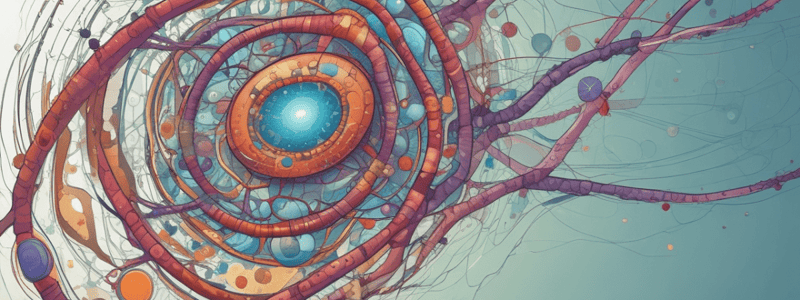Podcast
Questions and Answers
What percentage of the cell's weight corresponds to molecules related to gene expression?
What percentage of the cell's weight corresponds to molecules related to gene expression?
- 25% (correct)
- 50%
- 20%
- 75%
What is the approximate number of proteins synthesized from one mRNA molecule?
What is the approximate number of proteins synthesized from one mRNA molecule?
- 100
- 10000
- 3500 (correct)
- 5000
What percentage of a cell's energy expenditure is dedicated to translation during growth?
What percentage of a cell's energy expenditure is dedicated to translation during growth?
- 76% (correct)
- 60%
- 40%
- 50%
What percentage of transcription in yeast is dedicated to RNA polymerase I?
What percentage of transcription in yeast is dedicated to RNA polymerase I?
What is the primary function of aminoacyl tRNA synthetases?
What is the primary function of aminoacyl tRNA synthetases?
What is the hypothesized origin of the first components of the translational machinery?
What is the hypothesized origin of the first components of the translational machinery?
What is thought to be the first component of the translational machinery to emerge?
What is thought to be the first component of the translational machinery to emerge?
What is the role of ATP, GTP, and Mg2+ in translation?
What is the role of ATP, GTP, and Mg2+ in translation?
What percentage of transcription is dedicated to ribosomal proteins?
What percentage of transcription is dedicated to ribosomal proteins?
What is the relationship between the sequence of RNA and the sequence of proteins synthesized?
What is the relationship between the sequence of RNA and the sequence of proteins synthesized?
Study Notes
Translation Machinery Components
- Translation is the final step of gene expression, accounting for 25% of the cell's weight in molecules related to gene expression.
- A cell produces approximately 3,500 proteins from one mRNA, making protein synthesis a costly process for the cell, much more so than transcription.
- 76% of the cell's energy expenditure is dedicated to translation during growth.
- In yeast, 60% of transcription is RNA pol I, 10% is RNA pol III, and over 20% of RNA pol II is dedicated to ribosomal proteins, making up >75% of transcription focused on translation machinery.
Origin of Translation Machinery
- The RNA world, lacking ribosomes and proteins, saw the emergence of the genetic code and the first proteins organized according to RNA sequence.
- Initial translations occurred spontaneously, generating the first proteins that gave rise to ribosomes.
- tRNA is thought to be the first element of the translation machinery to appear, being purely RNA-based.
- The peptidyl-transferase activity is present in rRNA and can occur in the absence of enzymes, although it's not favorable.
- This suggests that once tRNAs are charged, they recognize messenger codons, facilitating the transpeptidation reaction.
- The autogenous protoribosome emerged later, with the insertion of proteins that aid stabilization.
- Aminoacyl-tRNA synthetases (AaRS) are more recent, having appeared twice, and are still evolving.
Studying That Suits You
Use AI to generate personalized quizzes and flashcards to suit your learning preferences.
Description
Learn about the components of translation machinery, the final step of gene expression. Discover the energy cost and protein production process in cells. Test your knowledge of cellular biology and gene expression!




